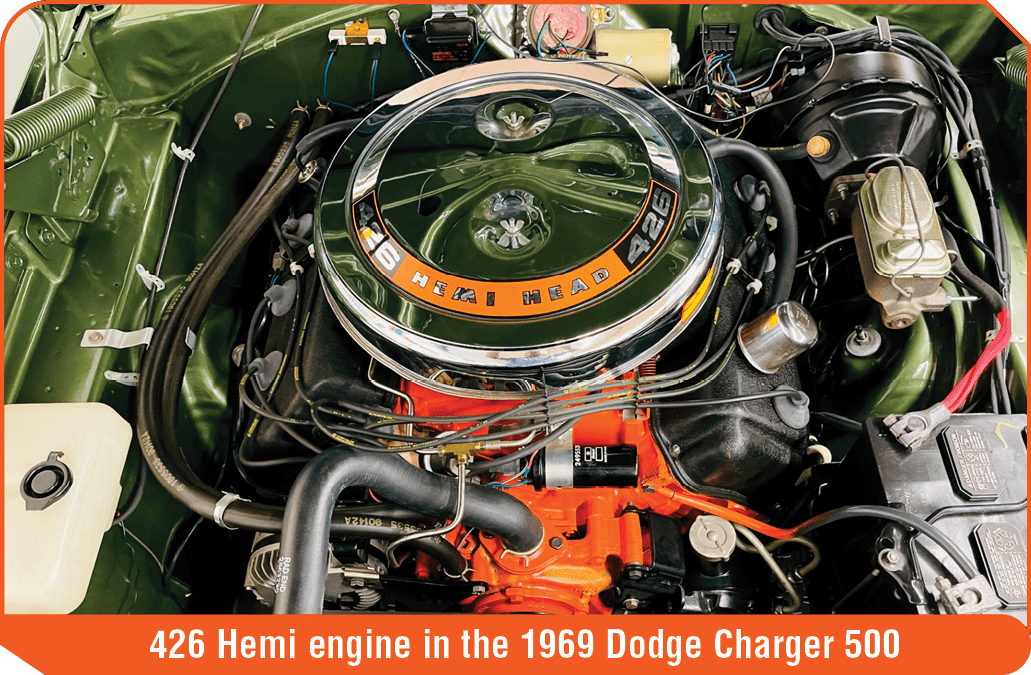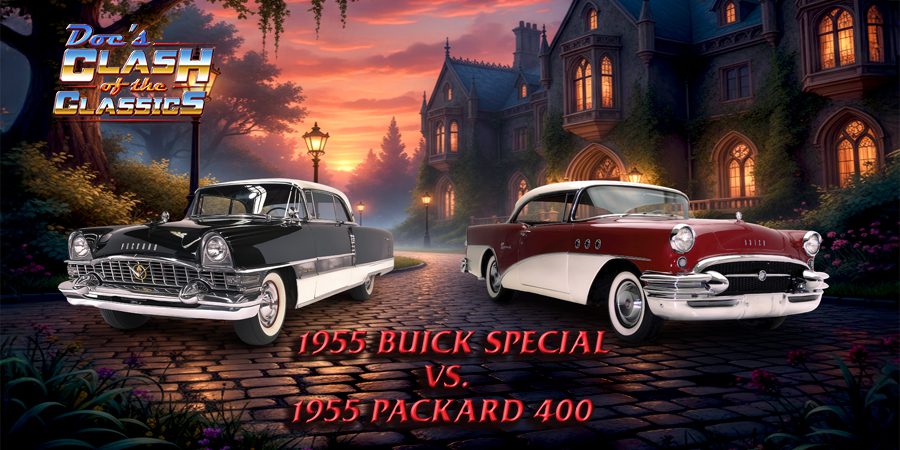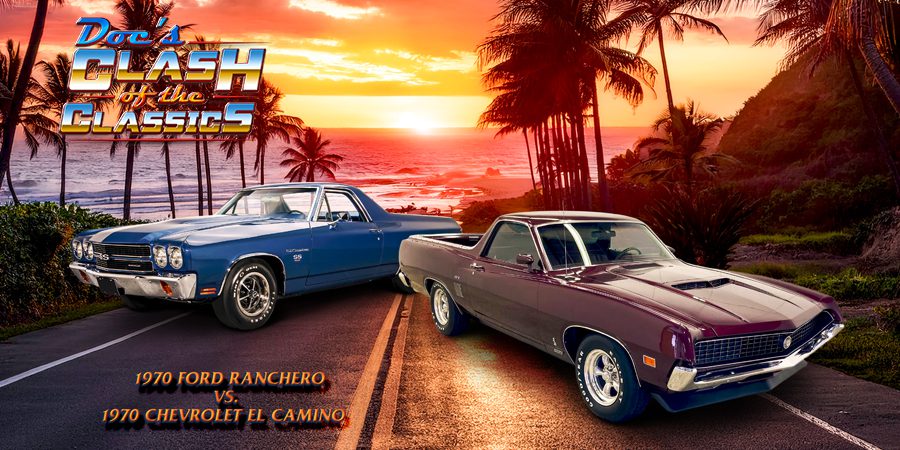Welcome once again to another edition of Doc’s Clash of the Classics. This month we’ll look back to 1969 for a battle between two rare muscle cars that don’t often get the attention they deserve. Today’s battle is between the 1969 Dodge Charger 500 and the 1969 Ford Torino Talladega.
Back in the late 1960’s Chrysler and Ford were continually experimenting with exterior body shapes to make some models more aerodynamic, or in simple terms, make them faster. NASCAR was a huge market with a huge audience and winning at the track was paramount. Richard Petty, Al Unser, and Buddy Arrington were all driving Mopars in 1968 and Chrysler was enjoying the fruits of their success.
 In those days, these experiments were referred to as “Aero Wars”, and of the big 3 automakers, Dodge was arguably the battle leader. It was an interesting time for the Chrysler Corporation in particular because they were building and selling some of the most outrageous cars ever designed. One need not look any further than the Dodge Daytona for proof with its ugly rear spoiler and odd looking pointed front nose.
In those days, these experiments were referred to as “Aero Wars”, and of the big 3 automakers, Dodge was arguably the battle leader. It was an interesting time for the Chrysler Corporation in particular because they were building and selling some of the most outrageous cars ever designed. One need not look any further than the Dodge Daytona for proof with its ugly rear spoiler and odd looking pointed front nose.
Going back a few years, by 1965, It had become common knowledge in the automotive industry that horsepower alone was not enough to win in NASCAR. Developing the engine to produce sufficient power was not the problem, the issue was unstable and unpredictable handling at higher track speeds.
In 1968 Dodge had redesigned the body for the Charger, it looked great, sold reasonably well, and even won awards, but it didn’t do so well on the race track. That was more of a problem than it might seem because the track was precisely where Chrysler wanted to, needed to do well. During that time, it was well known that winning on Sunday meant showroom sales on Monday. To solve the problem with the Charger design, Chrysler consulted with advanced scientists to develop a streamline approach to the exterior body design.
 Using a wind tunnel, these engineers identified flaws in the structure of the grille, absence of a lower spoiler at the front, and a design problem at the rear window causing drag. After making adjustments and implementing them into the 1968 Charger front grille, lower spoiler, and rear glass, wind tunnel test results improved significantly and many of the Charger’s aerodynamic problems were solved.
Using a wind tunnel, these engineers identified flaws in the structure of the grille, absence of a lower spoiler at the front, and a design problem at the rear window causing drag. After making adjustments and implementing them into the 1968 Charger front grille, lower spoiler, and rear glass, wind tunnel test results improved significantly and many of the Charger’s aerodynamic problems were solved.
Those changes and improvements helped give birth to one of the best looking, best handling cars of the time period, it’s the ’69 Dodge Charger 500. It is certainly a rare vehicle and not widely known due to a very limited number of them being produced. However, of all the cars we’ve had opportunity to experience here at “Clash of the Classics”, this car is possibly the coolest of them all.
NASCAR, at that time had a requirement that a minimum of 500 cars be sold to the general public for a car to qualify as a “stock” vehicle. After the design changes to the Charger body proved to be effective, Dodge issued the green-light for the cars to be sold to the public. The redesigned Charger was now called the “Charger 500”.
The car was introduced to the press and to NASCAR founder Bill France in June of 1968. Mr. France had only one issue with the newly designed car and that was the spoiler Dodge had placed under the front bumper. Apparently at that time, NASCAR objected to any aerodynamic modifications that made the vehicle look more like a race car than a street car.
Chrysler management argued strenuously that there was precedent with regard to the spoiler and after further persuasion from Chrysler Management, Mr. France relented and the front spoiler was allowed.
 Then in July of 1968, Dodge dealers were told the 1969 Charger would be available in limited numbers and with only two engine options, the 426 Hemi or the 440 Magnum. The base price for a 440 equipped car was approximately $3,843, the Hemi-equipped models were priced higher at approximately $5,500. Many experts today believe the cars were sold at a loss in an effort to pique curiosity and interest.
Then in July of 1968, Dodge dealers were told the 1969 Charger would be available in limited numbers and with only two engine options, the 426 Hemi or the 440 Magnum. The base price for a 440 equipped car was approximately $3,843, the Hemi-equipped models were priced higher at approximately $5,500. Many experts today believe the cars were sold at a loss in an effort to pique curiosity and interest.
At some point, it is believed that Dodge either gave up producing the car or NASCAR officials weren’t counting how many cars Dodge produced because most industry experts and aficionados agree that only 392 Dodge Charger 500s were built and publicly sold.
Unfortunately, the Charger 500 never competed at the level Chrysler had envisioned. Ultimately, the Dodge Charger Daytona with the aforementioned odd looking nosecone and ugly oversized rear wing went on to become the popular model. In comparison, it is estimated that 503 Charger Daytona’s were built and sold in 1969, and while it is a rare car, the Charger 500 is actually rarer. A level 2 Dodge Charger 500 is estimated by some to have a value of $180,000 or more. If you have one, please message us here at the email provided in this article, we’d love to speak to you.
Alright, let’s talk about the 1969 Ford Torino Talladega.
For much of the 1960’s Ford found themselves continually trailing their quicker Mopar and GM muscle car rivals. In the showrooms, with the exception of the Mustang, which is considered a Pony Car, Ford had little to offer performance-minded enthusiasts other than the Galaxie, the Fairlane, or the Thunderbird. These cars were heavy and they were no competition for the more powerful GM and Mopar muscle lineup. But, the Blue Oval team had a plan…

In NASCAR, Indy 500, and LeMans, Ford was consistently successful, there was no doubt they knew how to win and in 1969 they did just that.
As we alluded to earlier, the late ‘60’s and early ‘70’s muscle car market was arguably dominated by Chrysler’s sleek and streamlined designs. Chevrolet was doing well with their Chevelle sales, Pontiac was selling every GTO they could build and even Oldsmobile had their fifteen minutes of fame with the ever popular 4-4-2. However, now, there was a new contender, it was the 1969 Ford Torino Talladega. It was named after NASCAR’s newest super speedway and it was so hot, Richard Petty defected from Plymouth to drive it.
It was Ford’s answer to the Dodge Charger 500 and just like Dodge, Ford was required to build at least 500 street versions to qualify it for racing. It was based on the ’69 Fairlane Cobra “SportsRoof”, but with some critical aerodynamic improvements.
The front of the car was streamlined and stretched approximately five inches with a more tapered design. The grill was mounted flush with the front of the car, the rocker panels were raised about one inch so the race cars could be lowered and still comply with NASCAR’s ride height requirements.
 Early NASCAR versions of the Talladega ran the Ford 427 cubic inch V8, then later in the season some teams opted to run the Boss 429. By comparison, all street Talladega’s were fitted with the 428 Cobra Jet, it was the second year of production for the engine and there is an interesting back story to its development. Ford rated the engine at 335 horsepower and 440 lb-ft of torque, but most agree those numbers are grossly understated.
Early NASCAR versions of the Talladega ran the Ford 427 cubic inch V8, then later in the season some teams opted to run the Boss 429. By comparison, all street Talladega’s were fitted with the 428 Cobra Jet, it was the second year of production for the engine and there is an interesting back story to its development. Ford rated the engine at 335 horsepower and 440 lb-ft of torque, but most agree those numbers are grossly understated.
There are at least two theories as to why the horsepower ratings were reported so low, one of them had to do with making the car more insurable, the other had to do with a possible ploy Ford was using to distract the NHRA from the Cobra Jets real power. The hope (allegedly) was to gain more advantageous classification in Stock and Super Stock competition. Regardless of which theory is factual, most dyno test results put the actual 428 Cobra Jet power at 400 horsepower. Curiously, none had ram air, but all street Talladega’s got a factory drag pack engine oil cooler.
The only transmission available was a column-shifted C6 with a modified valve body, the rear differential ratio was a 3.25:1 and there were no substitutions or options.
The interiors were for the most part stripped down with a vinyl-wrapped bench seat and the standard utilitarian style dash with the classic four-port instrumentation layout used in the Fairlane.
 Ford’s Mercury Division copied the idea and came up with the 1969 Mercury Cyclone Spoiler II. It was almost identical to the Talladega, the main differences were badging and engines. While all street versions of the Talladega got the 428 Cobra Jet engine, the Cyclone was fitted with the 351 Windsor. One other notable cosmetic difference was the rear spoiler on the Mercury. It was not offered on the Talladega and I have never understood why it wasn’t. To me, it gave the car an aggressive, track-like look that should have been an obvious inclusion.
Ford’s Mercury Division copied the idea and came up with the 1969 Mercury Cyclone Spoiler II. It was almost identical to the Talladega, the main differences were badging and engines. While all street versions of the Talladega got the 428 Cobra Jet engine, the Cyclone was fitted with the 351 Windsor. One other notable cosmetic difference was the rear spoiler on the Mercury. It was not offered on the Talladega and I have never understood why it wasn’t. To me, it gave the car an aggressive, track-like look that should have been an obvious inclusion.
Years ago, Doc Morgulis, myself, and our staff at Horsepower Broadcasting, hosted the “Fabulous Ford’s Forever” show in Southern California. It is a huge event that is attended by 30,000 people annually. During one of the shows, we had opportunity to see and experience an original 1969 Ford Torino Talladega. The owner had installed a Cyclone spoiler on the deck lid and it looked remarkably good. We had the pleasure of driving the car around the Southern California streets for quite some time and the feel is somewhat indescribable. There’s just something about a late ‘60’s muscle car that makes you feel eternally youthful.
As far as the Ford Talladega’s success on the racing circuit is concerned, it delivered exactly what Ford had hoped. David Pearson won the 1969 NASCAR title in the “69 Torino Talladega, Richard Petty won eight races that year driving the Ford with an additional 29 Grand National victories being claimed that year by Ford’s aero warrior.
The battle between the “69 Dodge Charger 500 and the “69 Ford Talladega is so evenly matched it’s been difficult to determine a winner, both cars have a great story and both are a blast to drive. However, only one of them can emerge victorious and in this case, the nod goes to the Ford Torino Talladega.
The deciding factor comes as a result of the Ford Talladega being aerodynamically superior to the Dodge Charger. Remember, we discussed early on how Chrysler Corporation consulted with rocket scientists to develop an aerodynamically superior car for NASCAR’s superspeedways? Well, unfortunately for Dodge, those efforts proved futile for the 1969 race season and their hopes were dashed by Ford’s unlikely champion.
As always, we’d love to hear from you, let us know which car you prefer and why.
Until next time when we take a ride on a classic highway, stay safe… stay timeless… stay classic!
About The Author
Donny Caccamise is an Automotive Technology Graduate and a Certified Master Technician with more than 40 years of automotive industry experience. Before retiring, he hosted the Nationally Syndicated Automotive Talk Radio Show “Horsepower for an Hour” airing on 161 AM and FM radio stations across the nation. He is a retired member of the ATRA Board of Directors, and retired transmission shop owner. Vintage and classic cars are his specialty. Contact Donny at donnycaccamise@gmail.com


















Add Comment